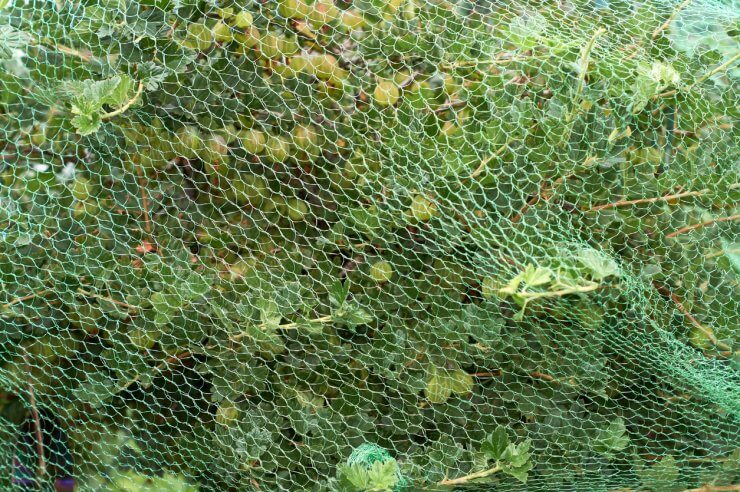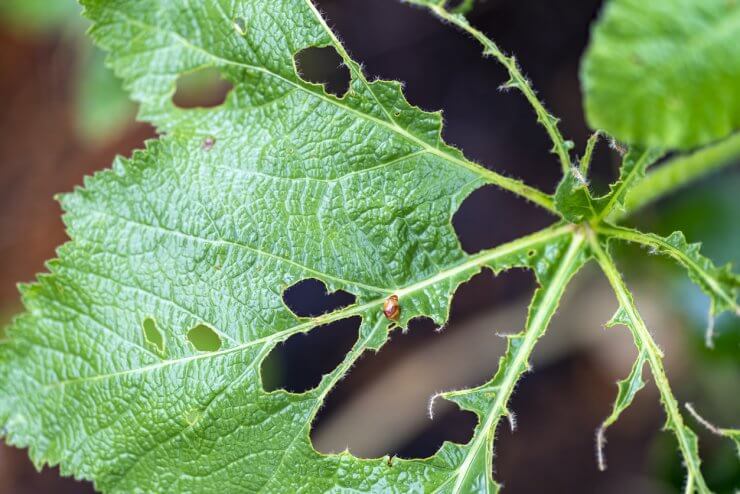
Gooseberries protected by netting to keep out larger wildlife
Pests on your gooseberry bushes, left unchecked, can damage and destroy your lovely plants. Keeping a close watch on your bushes during regular daily inspections will help you spot any pests before they can do irreparable harm. Healthy gooseberry bushes can bounce back from pest damage if you catch the pests quickly.
Spot the symptoms of gooseberry bush pests
Check leaves, branches, and fruit for these symptoms that come from pests on the prowl!
On Gooseberry Leaves and Branches/Canes
| Symptom | Pest |
| Whitish coating on underside of leaves or on branches; sometimes looks like blisterss | Scale |
| Tunneled holes through the pith of the gooseberry cane | Currant borer |
| Yellowing leaves; clusters of small “bumps” on underside of leaves | Aphids |
| Caterpillar-like larvae eat the leaves; larvae that survive become sawflies, which then lay more eggs, which become hungry larvae |
Imported currant worm |
| Sawflies lay eggs on shoot tips, encircling them; they die and fall off | Currant stem girdler |
| Irregularly shaped holes in leaves | Slugs, snails |
On Gooseberry Fruit
| Symptom | Pest |
| Hollowed-out, discolored berries | Gooseberry fruitworm |
| Broken, missing fruit | Birds |
How to treat pests on gooseberry bushes

Snail damage on gooseberry leaf
Here are some proven ways to get rid of pests on your gooseberry bushes. Choose the best treatment for the type of pests invading your plants.
- Pick off the pests. Use your garden gloves to remove the pests by hand. After removal, destroy pests by drowning them in a bucket of soapy water or crushing them with your foot. Handpicking isn’t efficient or practical for very small pests, but works well with larger pests.
- Cover up. If birds are making a meal of your gooseberries, you might want to drape some bird netting over the bushes. They’ll still get all the light they need, and you can deter your fine feathered friends. Perhaps there’s a suet cake or seed feeder you can use to lure them away from your garden? Some gardeners swear by grape Kool-Aid® — unsweetened —and mixed with water. Spray it on your gooseberries as they begin to mature; birds reportedly do not like the taste.
- Remove overripe or deformed fruit. If you notice any deformed fruit or fruit that looks like it’s rotting on the bush, remove it as soon as possible. Rotting fruit can attract pests that further damage your bush or cause disease.
- Apply insecticidal soap. Insecticidal soap is organic. The potassium salts in insecticidal soap help remove an insect’s protective waxes, causing destruction of insect membranes and killing them. Mix the soap with water to create your solution, and apply directly to insects on any plants. While insecticidal soap is less apt to affect other organisms, certain plants might be sensitive to the soap and can suffer leaf burn.
- Apply horticultural oils. Combine plant- or petroleum-based oils with water to produce horticultural sprays. Neem oil, for instance, is derived from seed extracts of the neem plant. Oil-based sprays block an insect’s air holes, interfere with an insect’s metabolism, disrupt insect feeding, and inhibit insect growth. Like insecticidal soaps, horticultural oils can cause plant injury if not properly diluted.
- Make your own pest spray. You can make your own pest spray with benign materials. Mix one tablespoon of baking soda, 1/2 teaspoon of a mild dish detergent, and 2 1/2 tablespoons of olive oil in a gallon of water to make a solution that will repel all kinds of bugs, as well as a fungicide for mildew on the gooseberry plant leaves. Shake it well in your bottle before spraying and repeat every week for it to be continuously effective.
- Trap them. Gooseberry bushes grow too close to the ground for you to create a barrier to keep pests from climbing up from the ground. But you can divert them. If you suspect a snail or slug problem (look for the slime trail), you can try luring them out at night by watering the plants you think are affected in the late afternoon. After sundown, go out with rubber gloves and a bucket of soapy water. Using a flashlight, look for the slugs and place them in your bucket until they die. You can also buy commercial snail/slug bait and traps. It’s partly a matter of which method will give you more gardening satisfaction.
- If your bush is infested, act quickly. If you discover that your gooseberry bush is infested and you’ve tried all natural or store-bought pest solutions and still can’t control it, you may need to cut off and destroy any infected plant material. And remember not to compost it! You don’t want to create a home for future infestations.
Do pests attack your gooseberry bushes every year? How do you handle removing them—and even preventing them in the first place? Please tell us how you treat your gooseberry bushes to avoid pests.


 Previous
Previous


All my gooseberry leafs have been ate